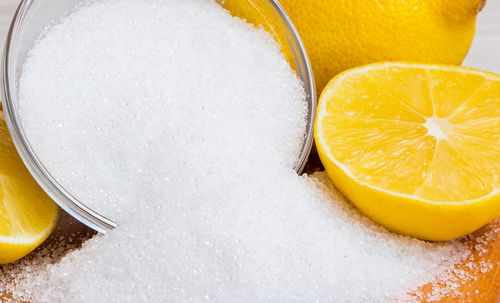Thanks to its diverse benefits, Citric Acid is a popular choice for natural formulations.
It can adjust and correct pH levels, improve product stability and shelf-life, enhance the performance of other active ingredients, and even create delightful fizzing effects
in bath and spa products.
Furthermore, Citric Acid offers a host of skincare benefits. As an AHA acid, it promotes skin exfoliation for a fresher, firmer complexion, while its antioxidant properties make it a valuable ingredient in anti-aging skincare products.
Citric Acid is a naturally occurring compound that is abundant in citrus fruits like lemons, limes, oranges, and grapefruits. While it has an essential role in the metabolic processes of living organisms, it is also commercially produced for industrial applications in the food, cosmetics, and pharmaceutical industries.
As a versatile raw material, Citric Acid can be found in a wide range of products across various sectors. In food and beverages, it can serve as a preservative, pH regulator, stabilizer, and acidulant, adding a sharp, sour taste to the finished product. In pharmaceuticals, it can act as an anticoagulant and chelating agent, helping to prevent blood clots. In cosmetics and personal care products, Citric Acid is an affordable ingredient often used to make bath bombs and adjust the pH levels of formulations.
NDA's Citric Acid (Anhydrous USP/FCC) Raw Material is a top-quality, fine crystalline powder produced through the fermentation of corn and sugar beets. It meets the monograph standards of the USP (United States Pharmacopeia) and FCC (Food Chemical Codex) and is free from genetically modified organisms (GMOs).
The benefits of Citric Acid.
Citric Acid offers a wealth of benefits for use in cosmetics and personal care products. Its fine, uniform powder consistency allows for easy dissolution in water and effortless blending with other ingredients, making it a versatile and valuable addition to many formulations, including all-natural products.
One of the key benefits of Citric Acid is its ability to adjust and regulate the pH of products. As a weak organic acid, it can effectively lower the pH of formulations, which can help to increase their efficacy and stability.
Additionally, Citric Acid can act as a chelating agent, which means it can bind to metal ions and help to remove impurities from formulations. This property is particularly useful in cosmetic products, as it can help to improve their texture and appearance.
Citric Acid also offers exfoliating benefits for the skin. As an alpha hydroxy acid (AHA), it can help to promote cell turnover and reveal fresher, smoother, and brighter-looking skin. It also has antioxidant properties, making it a valuable addition to anti-aging formulations. Overall, Citric Acid is a versatile and beneficial ingredient that can enhance the performance and stability of cosmetic and personal care products. Maintaining the proper pH level in skincare formulations is essential for both product quality and safety. An optimal pH can improve the efficacy of active ingredients, enhance the sensory experience of the product, and reduce the likelihood of irritation or other adverse reactions. In addition to its other benefits, Citric Acid is a popular ingredient used for pH adjustment in skincare and personal care formulations. As a weak organic acid, it can effectively lower the pH of a product, making it more acidic and improving its overall stability and performance. By carefully adjusting the pH of a formulation with Citric Acid, formulators can ensure that their products are safe, effective, and enjoyable to use. This can help to improve customer satisfaction and build brand loyalty over time.
Citric Acid plays an important role in maintaining the stability and longevity of cosmetic products. In addition to pH adjustment, Citric Acid also has chelating properties that can help to improve the efficacy of preservatives and antioxidants.
Chelating agents like Citric Acid work by binding to trace metal ions in a product, preventing them from reacting with other ingredients and degrading the product over time. This can help to prevent rancidity, discoloration, and other common problems that can occur in cosmetic formulations.
By using Citric Acid as a chelating agent, formulators can improve the stability and shelf-life of their products, ensuring that they remain effective and safe to use for longer periods of time. This can be especially important for products that are exposed to light, heat, or other environmental factors that can accelerate degradation.
In skincare, Citric Acid is recognized for its exfoliating and antioxidant properties. As an AHA (Alpha Hydroxy Acid), it can help remove dead skin cells, dirt and debris to reveal a brighter, smoother complexion. AHAs are commonly found in chemical peels and acne treatments for their ability to exfoliate the skin. Citric Acid also has antioxidant benefits, helping to protect the skin against free radical damage and contributing to a firmer, more toned appearance. Additionally, it can improve the appearance of scars, spots, and other pigmentation issues, leading to a more even skin tone.
Citric Acid is often used in shampoo formulations to bring the pH levels down, which improves the hair's appearance and manageability by reducing frizz. It can also be used in rinses to help lift or fade colors out of the hair.
Citric Acid is an essential ingredient in bath bomb formulations due to its ability to produce effervescence (fizzing) when combined with Baking Soda (Sodium Bicarbonate). This reaction is what creates the bubbling and fizzing effect that many people enjoy in their bath bombs. The reaction is caused by the Citric Acid reacting with the Baking Soda to release carbon dioxide gas, which creates the fizzy effect. This reaction can also help to break down oils and other ingredients in the bath bomb, allowing them to spread evenly throughout the water and provide a more relaxing and enjoyable experience.

